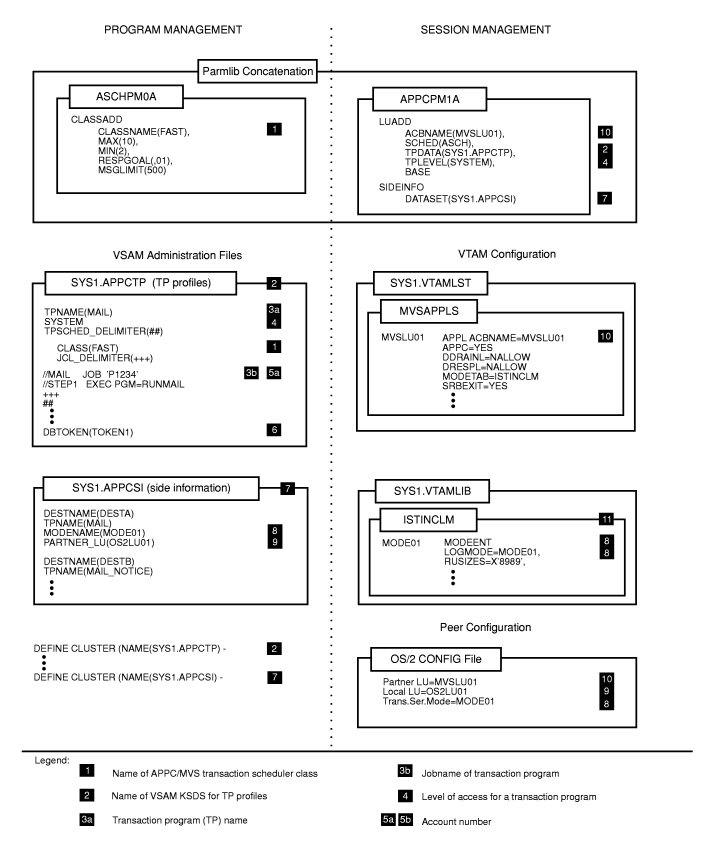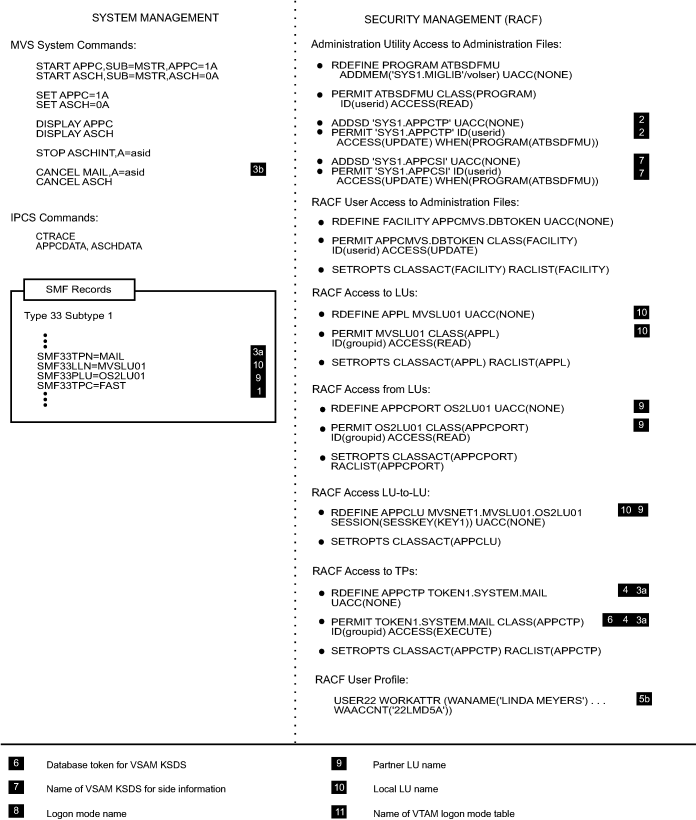shows the MVS support
structure for APPC/MVS using specific values. The examples, which
show only a subset of all possible situations, go across the four
management areas using values that are numbered. A description of
each numbered value follows:
- 1 Name of APPC/MVS transaction scheduler
class
A class of transaction initiators for the APPC/MVS transaction
scheduler must be defined in an ASCHPMxx member of the parmlib concatenation.
A TP is assigned to a class through a TP profile. An APPC/MVS transaction
scheduler class is recorded in an SMF type 33 subtype 1 record.
- 2 Name of VSAM KSDS for TP profiles
TP profiles are contained in a VSAM key sequenced data set (KSDS).
You must first define the VSAM KSDS with a DEFINE CLUSTER command
and then associate it to an LU in an LUADD statement within an APPCPMxx
member of the parmlib concatenation. If you need RACF® protection for the VSAM KSDS, define it
with a RACF ADDSD command and
then allow access to specifically named users.
- 3a Transaction program name
A
transaction program name can be from 1 to 64 characters long. It is
a required parameter in the TP profile key and may be, but does not
have to be, the same as the jobname in the TP profile JCL. The transaction
program name is recorded in an SMF type 33 record (subtypes 1 and
2). If you need RACF protection
for an individual TP, you can define the transaction program name
to a RACF APPCTP class. If
you specify TPNAME in the side information, it must match the TPNAME
in the TP profile, or the TP will not run. So, in Figure 1, the entry for TPNAME in SYS1.APPCTP
must match the entry for TPNAME in SYS1.APPCSI.
- 3b Jobname
A job name in the
TP profile is 1 to 8 characters long and is the name of the JCL job
that runs the transaction program. The job name can be, but does not
have to be, the same as the transaction program name used in the TP
profile key. To cancel a transaction program, use the job name and
address space identifier in a CANCEL command.
- 4 Level of access for a transaction
program
Transaction program execution access is determined by
the level of the TP profile and the level of the LU through which
the transaction program communicates. RACF can
use the level of access to specifically define access to each transaction
program and its TP profile.
- 5a 5b Account
number
An account number can be assigned to a transaction program
in TP profile JCL (5a) or in a RACF user
profile (5b). When the TP's account is to be tailored, the account
number comes from the RACF user
profile. SMF can audit a TP using either account number.
- 6 Database token for VSAM KSDS
You
can assign a database token to each VSAM KSDS to represent the file
name in RACF security definitions
that give access to TPs.
- 7 Name of VSAM KSDS for side information
Side information is contained in a VSAM key sequenced data set
(KSDS). You must define the VSAM KSDS with a DEFINE CLUSTER command
and then associate it with an LU in a SIDEINFO statement within an
APPCPMxx parmlib member. If you need RACF protection
for the VSAM KSDS, define it with a RACF ADDSD
command and then allow access to specifically named users.
- 8 Logon mode name
A logon mode
contains the definition of session characteristics for network communication.
Logon modes are compiled entries in the VTAM® logon mode table in SYS1.VTAMLIB. (The
logon mode in this example is shown as uncompiled source.) When a
transaction program initiates a conversation, it must specify a logon
mode or indirectly specify it. In APPC/MVS, a TP can indirectly specify
a logon mode through a reference to side information.
- 9 Partner LU name
The partner
LU (logical unit) is the SNA type 6.2 LU that, in this example, is
located on a workstation. When an outbound transaction program initiates
a conversation, it can directly or indirectly specify the partner
LU. In z/OS,
a TP can indirectly specify the partner LU in side information. SMF
records the partner LU name in SMF type 33 records (subtypes 1 and
2). If RACF protection is required,
the partner LU is specified in RACF LU
access definitions.
- 10 Local LU name
The local LU
(logical unit) is the SNA type 6.2 LU that, in this example, is located
on an z/OS system.
In APPC/MVS, the local LU is defined by an LUADD statement in an APPCPMxx
parmlib member. In VTAM, the z/OS local
LU is defined by a VTAM APPL
definition statement in SYS1.VTAMLST.
- 11 Name of VTAM logon mode table
The VTAM logon mode table contains logon mode entries
that define network session characteristics. The logon modes available
for an z/OS local
LU are contained in the table named after the MODETAB parameter in
the LU's VTAM APPL statement.
 z/OS MVS Planning: APPC/MVS Management
z/OS MVS Planning: APPC/MVS Management
 z/OS MVS Planning: APPC/MVS Management
z/OS MVS Planning: APPC/MVS Management





 Copyright IBM Corporation 1990, 2014
Copyright IBM Corporation 1990, 2014